The Role of No-Code Platforms in Application Development
The world thrives on simple solutions. Before smartphones, we relied on basic phones for calls and text messages. Similarly, no-code platforms in application development have simplified the app creation process, much like these earlier innovations simplified communication. Businesses and developers increasingly adopt no-code platforms to meet the growing application demand. However, what are no-code platforms, and why are they gaining such popularity?
Understanding No-Code Platforms
No-code platforms allow users to create applications without requiring coding knowledge. These platforms use visual interfaces and drag-and-drop functionality, making app development accessible to everyone.
Quick Facts:
- No-code platforms gained traction during the COVID-19 pandemic.
- They rely on pre-made templates to meet basic app needs.
- Over 500 million new apps will be created in the next seven years, a demand traditional development methods can’t meet.
- The shortage of software developers has fueled the rise of no-code platforms as a viable alternative.
No-code platforms have revolutionized app development, offering a simpler and faster way to bring ideas to life.
Benefits of No-Code Platforms in Application Development
No-code platforms offer numerous advantages that make them an appealing choice for businesses and developers alike:
- Accessibility: Minimal technical skills are needed to use no-code platforms.
- Affordability: App development is much cheaper compared to traditional methods.
- Speed: Applications can launch in weeks rather than months or years.
- Collaboration: Both technical and non-technical teams can work together more effectively.
- Innovation: Teams can quickly prototype and test ideas without significant costs.
Given these benefits, the use of no-code platforms in application development is expected to grow by 45% by 2025.
Limitations of No-Code Platforms
Despite their many advantages, no-code platforms have some limitations:
- Customization Constraints: Templates may not fully meet unique business needs without the help of professional developers.
- Vendor Dependency: Companies face risks like terms, pricing, or platform closure changes.
- Scalability Issues: While suitable for initial launches, no-code apps may struggle to scale with growing business needs.
- Security Concerns: Entrusting sensitive data to third-party platforms can pose risks.
Some providers claim their platforms offer satisfactory scalability, depending on the product and its requirements.
Industries That Benefit Most from No-Code Platforms
No-code platforms are particularly useful in the following sectors:
1. Startups
Startups often face limited resources and tight timelines. No-code platforms help them:
- Build prototypes to attract investors.
- Launch products quickly.
- Bridge skill gaps without hiring specialized talent.
- Automate repetitive tasks, freeing up valuable time.
2. Marketing
Marketers can use no-code platforms to:
- Create app prototypes for client feedback.
- Build campaign tracking tools.
- Design personalized landing pages quickly and affordably.
3. Education
Educational institutions benefit from no-code platforms by:
- Setting up learning management systems.
- Launching interactive online courses.
- Tracking performance efficiently.
- Enhancing communication between students and faculty.
4. Healthcare
Implementing digital healthcare solutions through no-code platforms by:
- Developing appointment scheduling apps.
- Creating tools for performance tracking.
- Improving patient-provider communication while ensuring compliance with regulations.
5. eCommerce
ECommerce businesses use no-code platforms to:
- Launch online stores with integrated payment systems.
- Develop customer forms and streamline workflows.
6. Customer Support
No-code tools simplify customer support by:
- Organizing customer queries.
- Creating detailed FAQs efficiently.
Tips for Using No-Code Platforms Effectively
To maximize the potential of no-code platforms in application development, follow these tips:
- Start Small: Begin with a simple project to understand the platform’s capabilities.
- Choose Suitable Templates: Select templates that align with your project’s needs and customize them to match your brand.
- Set Long-Term Goals: Define your app’s purpose now and in the future.
- Test Thoroughly: Identify bugs and gather feedback to improve your app.
- Plan for Growth: Use no-code platforms to launch quickly, but invest in high-level developers to build scalable and customized solutions as your business grows.
Final Thoughts
No-code platforms in application development have revolutionized the industry, enabling businesses to launch apps quickly, affordably, and efficiently. These platforms simplify the development process, empowering teams to bring their ideas to life without extensive technical expertise.
While no-code platforms are not without limitations, their benefits far outweigh the drawbacks for most businesses. Start with no-code platforms to save time and resources, and when ready, transition to more complex and scalable solutions. The future of app development is here, and it is no code.
Recommended Articles
We hope this guide helps you understand the role of no-code platforms in application development. Explore these recommended articles for more insights on no-code tools and best practices in app creation.

